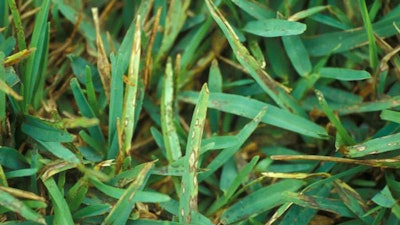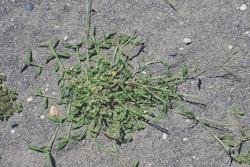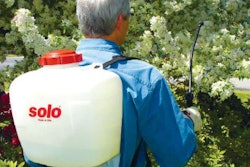
As is common with turf diseases, gray leaf spot develops rapidly in areas with abundant moisture and warm weather in the spring and early summer. If left to its own devices, this disease will eventually kill areas of turf, causing the leaves to wither and die. During severe outbreaks on warm- or cool-season turfgrass, infected turf will develop irregular yellowed and thinned patches, which may be several feet in diameter.
While the disease may seem to attack indiscriminately, shaded areas are particularly vulnerable. Other factors promote susceptibility to the disease as well, including high nitrogen fertilization, the use of herbicides that weaken turf, thatch problems and compacted soils or overall drainage problems.
Cultural control
Disease problems are more severe when the turf stays constantly moist. While you can’t control rainfall, which will be especially frequent during the spring, you can advise your clients on how and when to irrigate. Deep, infrequent irrigation is best, so that turf gets only the water it needs, where it needs it: down deep into its root zone.
Ideally, the topsoil should dry out some in-between waterings. Ask clients to water early in the morning and never in the evening. Evening irrigation results in leaf surfaces being damp all night, which is an invitation for disease. Morning waterings will result in turf blades drying more quickly in the sun, which will discourage disease. And turf should not be watered every day.
To reduce the severity of gray leaf spot, carefully evaluate your fertilization program. Make only moderate to low nitrogen applications, especially in areas where turf is shaded. Many times, herbicides will weaken turf, making it less able to fend off disease. If herbicides are absolutely necessary, use them sparingly on shaded lawns. But it’s best to avoid them altogether in these areas. Also, don’t leave grass clippings on lawns where gray leaf spot is a problem. Catch the clippings while you are moving and remove them.
If drainage is poor, look for ways to improve it. Often, this is as simple as aerating turf to increase water movement through the soil and lesson compaction. And too much thatch can create a favorable medium for fungal growth. Vertical mowing will alleviate thatch build up and promote healthy turf.
Another effective tool for controlling gray leaf spot is to establish a disease-resistant turfgrass, especially in areas most prone to disease. There are resistant varieties of perennial ryegrass (such as Paragon), St. Augustine grass (the cultivars Floratam, Delmar and Jade) and tall fescue (Apache II, Coronado, Coyote, Durango, Gazelle and Vegas).
Chemical control
Sometimes all the good cultural practices in the world are still not enough to eliminate the potential for disease. If the lawn has a history of disease outbreaks, fungicide application is warranted.
To help prevent disease outbreaks on turf with a history of succumbing to gray leaf spot, begin by making protective treatments before you can see damage in late spring or early summer. You’ll continue making applications at the recommended intervals until the threat of disease has passed. You can also use fungicides as a curative treatment for gray leaf spot, but preventive applications are the most successful. Here are some options:
- Azoxystrobin (Heritage) provides excellent control. Apply it in intervals of 14 to 28 days.
- Myclobutanil (Eagle, Immunox) provides fair to good control with an application interval of 14 days.
- Propiconazole (Banner Maxx) provides good control at an application interval of 14 days.
- Pyraclostrobin (Insignia) provides good control at an application interval of 7 to 14 days.
- Thiophanate-methly (Cleary 3336, Cavalier) provides good control at an application interval of 7 to 14 days.
For best results, always mow and irrigate before you apply a fungicide. Remember, the chemicals and application intervals listed above are only for reference. They are not a recommendation for use, nor are they a substitution for application instructions. As always, consult the product label and follow all label instructions.











